Port of Gothenburg, Sweden
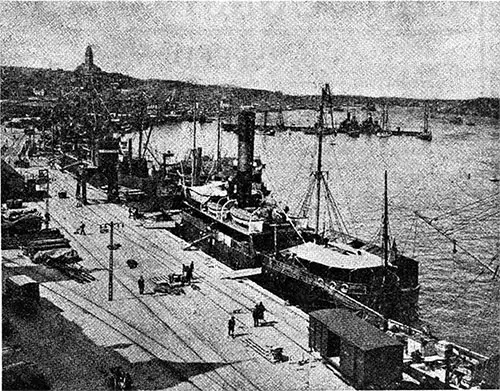
The Port of Gothenburg, Sweden, Which is Being Enlarged and Modernized to Handle Greatly Increased Traffic. Photo circa 1919. GGA Image ID # 1455eade10
The Gothenburg Free Port has a total pier frontage of 3.640 feet with 30 feet of water alongside. A concrete warehouse of five stories. and several enclosed sheds have been built for the storage and parceling of goods.
Gothenburg as a Shipping Center
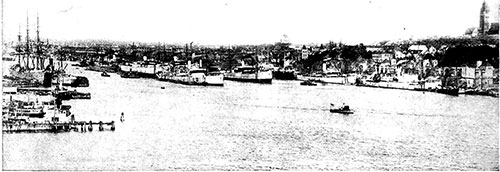
View of the Port of Gothenburg, Sweden circa 1923. GGA Image ID # 1457084040
Great Swedish Port ls Entering Upon a Period of Prosperity and Is Rapidly Becoming the Main Gateway for the Commerce of Scandinavia and States Beyond the Baltic.
An Interesting Letter from the Marine Journal's Swedish Correspondent
Gothenburg, July 18, 1923
A GOLDEN cross upon a field of blue——that is the Swedish ensign, and when you see it in New York Harbor or in any other harbor of the world the chances are about nine out of ten that the vessel hails from Goteborg (usually called Gothenburg by English speaking people), for that is Sweden's greatest seaport.
And, what is more important, statistics just made public indicate that Gothenburg is entering upon a period of prosperity which is likely to establish it as the greatest seaport in the north of Europe, the main gateway for the commerce of Scandinavia and the States beyond the Baltic.
During the first five months of 1923, 1.246 vessels from foreign ports entered the harbor of Gothenburg, while during the same period 1,164 vessels cleared for foreign ports. In addition 114 vessels entered the customs zone from the Free Port of Gothenburg during these months. while 72 vessels left the customs zone for the Free Port.
Compared with the figures for the corresponding period of last year, these statistics show a marked increase in the volume of ocean traffic handled. and compared with the figures for other northern ports they show that Gothenburg is likely to outrival Copenhagen and thus become the leading seaport in all Scandinavia.
The growing importance of this port in the Swedish trade with America is shown by statistics recently compiled by Mr. Walter H. Sholes, American Consul in Gothenburg. from which it appears that the value of the total exports via Gothenburg to America last year was $10,500,000.00, as against $6,400,000.00 during 1921.
The same high authority has also compiled figures showing that in twenty years there has been "a more than forty-fold increase in arrivals and a seventy-five-fold increase in net tonnage from America." And the American Consul adds that "naturally the possibilities and facilities of a port showing such a rapid growth are of particular interest to the growing maritime interests of the United States."
A number of recent events have served to attract attention to the new importance of Gothenburg as a shipping center. One, which the American Consul considers significant, is the action of the United States Shipping Board in transferring its Scandinavian office from Copenhagen to Gothenburg.
This city was chosen also for the annual meeting of the Baltic and White Sea Conference, which took place during the latter port of June this year and was attended by over one hundred delegates from England. Germany, Holland, Belgium, Sweden, Denmark, Norway, and Finland.
This Conference now has a membership of nearly 300 steamship owners and over 200 ship brokers. and the decisions of these experts are of very great force in all northern shipping activities.
Gothenburg has a further attraction this summer, not only for general tourists, but for businessmen as well, in the Tercentennial jubilee Exposition. This fair commemorates the founding of the city, three hundred years ago, as the outlet for Sweden's westward trade, and most of the city's history since that day is bound up with seafaring and over-seas commerce.
Space does not permit a discussion here of Gothenburg's importance as a seaport during the early Swedish voyages of exploration and settlement in America, or during the heyday of the Swedish East India Company.
Nor may we say anything here of the active traffic in this port during the American Revolutionary War, during the Napoleonic wars, or "during the First World War. Each of these events has given considerable impetus to the development of Gothenburg as a maritime center of the North.
It is a curious thing, however, that Sweden, in spite of her long history as a maritime nation, was comparatively slow in developing steam navigation. Until twenty years ago most of Sweden's transoceanic freights were carried in either British or German vessels.
The first regular Swedish cargo service between Gothenburg and the United States began in 1923 with the establishment of the Swedish America-Mexico Line. This company now has a fleet of ten vessels, which make regular calls at half a dozen American ports. from Boston to Galveston, as well as Vera Cruz and Havana.
Gothenburg is the home port, also. of the powerful Rederiaktiebolaget Transatlantic (Transatlantic Shipping Company, Ltd.) This company now operates 33 steamers, including several sea-going motor ships of over 9,000 tons deadweight.
Their service extends to America, South Africa. Australia, the Dutch East Indies, and Persia. A third company which has done much to put Gothenburg on the shipping map is the Swedish American Line, established in 1915.
Three liners. the S. S. Stockholm, the S. S. Drottningholm, and the S. S. Kungsholm maintain a regular passenger and freight schedule between the Swedish home port and New York. A fourth ship, the largest motor-driven vessel in the world, is now being built for this line and will be delivered next year.
Besides the three large steamship companies named above. Gothenburg has a number of smaller lines with service to nearby ports, both foreign and domestic, and it is estimated that some 50 or 60 owners of tramps have their headquarters in this city.
The harbor itself is well protected, being a part of the Gota River. It has a pier frontage of over five miles, outside of the Free Port. Conspicuous on all the piers are the electric cranes, some of them capable of lifting 50 tons, which facilitate the handling of cargo. There are three shipyards, equipped with dry docks and modern machinery for repairs and construction.
As an assembling or distributing point for foreign trade Gothenburg has the advantage of a radical system of railroads northward, eastward. and southward, covering the whole of Sweden, and connecting with the roads in Norway and Denmark.
The Gota Canal also has proved of tremendous advantage in providing cheap transportation via the large lakes to Stockholm.
During the last decade the subject of free ports and their importance in developing transit trade has been attracting much attention in Sweden. and three free ports have now been established, namely in Stockholm, in Malmö, and in Gothenburg.
The Free Port of Gothenburg, which cost the city more than $7,700.000.00 was opened in August I922 and immediately began to handle large transit shipments. Thus within the first two months it was used by nearly 250 vessels.
The Gothenburg Free Port has a total pier frontage of 3.640 feet with 30 feet of water alongside. A concrete warehouse of five stories. and several enclosed sheds have been built for the storage and parceling of goods.
The dock equipment includes 23 powerful cranes. And one 50-ton pontoon crane. The Swedish railroads connect directly with tidewater in the free zone, thus facilitating the transportation of goods going across the customs boundary into Sweden.
A number of the buildings within the free zone may be used for private offices, and the Goteborg Bank has established a branch office there.
The significance of the Free Port of Gothenburg in the development of Baltic commerce has been the subject of special reports recently sent to Washington by Mr. Walter H. Sholes, the American Consul in Gothenburg.
He points out that Sweden is destined to play a considerable role in the commerce of Russia, Latvia, Estonia, and Lithuania, because of her financial strength and stability. the possession of ample tonnage, and previous experience in dealing with those countries.
Gothenburg, he indicates, is the ideal port into which most of these new traffic routes will converge.
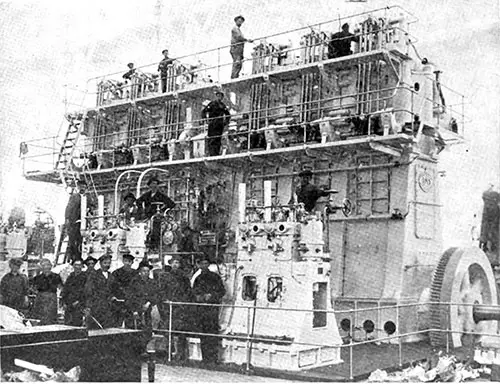
Diesel motor built by the Göta Works in Gothenburg. Sweden, and exhibited at the Tercentennial Jubilee Exposition, which is being held in Gothenburg this summer. This is a four-cycle, six-cylinder motor, developing 2,000-H.P. It is designed for a new Swedish motor-ship of 10,000 tons. and is the last word in marine engines of its class. GGA Image ID # 1457877368
Free Port of Gothenburg
FORMAL opening of Gothenburg's great free port system took place on August 31, 1922 the Crown Prince of Sweden being the chief figure in the attendant exercises.
To mark the memorable occasion the Harbor Board of the port have Issued and distributed a handsomely gotten-up booklet which, in addition to an account of port matters generally, features in considerable detail the administrative basis and equipment facilities on and through which the new free harbor will operate.
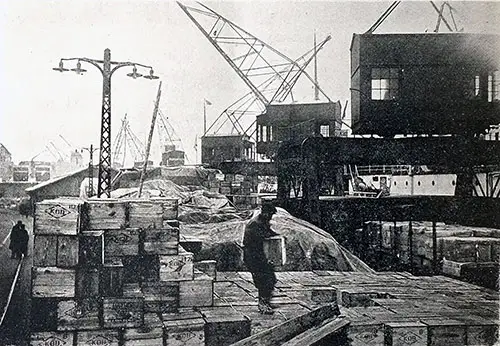
The Docks at Gothenburg, Sweden. GGA Image ID # 1457c38a0b
Gothenburg harbor, we find, is situated on both shores of the Göta River just above its outlet, which is sheltered by a large archipelago. The principal entrance is past the Vinga Lighthouse, erected on a rocky islet which marks the western or outer limit of the archipelago and the commencement of the Kattegat.
Vinga is ten nautical miles from Gothenburg and twenty-eight from the Skaw. The Göta Canal, a great commercial highway which runs across the entire width of Sweden from the Baltic to the North Sea, connects Gothenburg with the great lakes, Vanern and Vattern, and with Stockholm and the ports of the North Baltic.
In addition to this great inland waterway, Gothenburg is connected by rail with all parts of the Interior and also with other Scandinavian countries and with Finland and Russia.
The many lines which converge at Gothenburg are linked up by means of railway ferries with the great railway systems of the Continent. Negotiations are now proceeding between the governments of Sweden and Finland regarding the Introduction of ferries connecting the railway systems of these two countries.
This would result in a great increase of traffic via Gothenburg, especially during the winter months, when the ordinary communications with Finland and Russia are subject placed as a center for the collection and distribution of goods, not only from and to the interior of Sweden and the ports on iis long coast line, but also from and to neighboring countries.
The Harbor
The entrance to the Göta River is dredged to a uniform depth of 30 ft. The width up to Stigbergs Quay is 400 ft., and from thence up to the free harbor 350 ft. Above the free harbor the depth is 19 ft. and the width 130 ft. The area of the harbor is 1053 acres.
On both sides of the channel is a series of mooring buoys with accommodation for some forty vessels. These buoys are intended primarily for ships loading from and discharging into coasting vessels, canal steamers and lighters. On the left or south bank of the river is the fish market, which caters for the very extensive fish trade of the port.
The length of its quay is 3600 ft. There are also four quays intended for the handling of general cargoes. On the north bank Is Sannegards harbor, which has a quay length of 3000 ft. and is used chiefly for the coal and timber trades.
The total length of quays at the port is 27,000 ft., the water area is 900 acres, and the railway tracks total 33 miles. Sheds, other than warehouses, intended for general goods traffic have a floor space of 360,000 sq. ft. Most of the warehouses are privately owned.
The only building in the "Customs" harbor which belongs to the city is a warehouse intended for use as a bonded store, and, similarly, the city owns only one warehouse in the free harbor.
The free harbor lies on the right or north bank of the Göta River directly opposite the business quarter of Gothenburg, with which it is connected by the Hisings Bridge.
The harbor of Gothenburg, including the new free harbor, Is owned by the city of Gothenburg and administered by the Gothenburg Harbor Board. The members of this board are nominated by the Crown, the City Council, the magistracy of Gothenburg and the Gothenburg Chamber of Commerce.
Warehousing Arrangements
A private company, Goteborgs Frihamns A/B., has been Invested with authority to deal with all matters relating to the storing of goods. It has been created with the sole object of dealing in a careful and businesslike manner with all goods entering the warehouses, to the satisfaction of interested parties and at the lowest possible cost.
The chairman of this company, Th. Alpen, is a member of the Harbor Board. The manager Is Captain Sten Isberg.
This company manages the city's warehouse in the "Customs" harbor and issues certificates relating to goods. The regulations of the Harbor Board are established by royal decree.
The administration of the free harbor Is provided for by special act, authorized by the Swedish Legislature and embodying certain rules and regulations.
The most important of these provisions is that exempting the free harbor from customs dues. The free harbor Is not subject to the ordinary customs regulations as applied to the rest of Sweden, but is treated, in this respect, as a foreign country. Goods may be landed, stored for an unlimited period and shipped off again to other lands without being subject to any customs dues whatever.
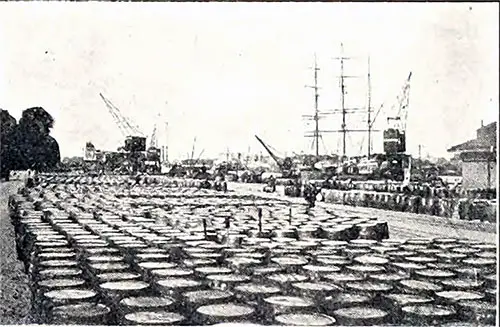
Scene at Gothenburg Harbor. GGA Image ID # 1457d7f394
Only as and when the goods cross what may be termed a "customs frontier" do they become subject to duty. When goods are forwarded to places within Sweden, provided that such places have a customs house, the customs dues are levied at the destination and not at Gothenburg.
All harbor dues levied on ships or goods are determined by the Swedish Government and all charges relating to labor within the free harbor are determined by the lord lieu tenant of the city and county in consultation with the Chamber of Commerce and the Association of Shipowners.
Charges for labor in the "customs" harbor are approved by the Chamber of Commerce but are not obligatory.
Owing to the unstable conditions which now obtain, It may be found necessary to modify the scale of dues from time to time, but it may be taken for granted that any changes will be in the direction of reduced dues, as the harbor authorities are most anxious to diminish all costs to the minimum.
Free Harbor Area to Be Enlarged
That portion of the harbor now completed is the first instalment of a scheme which contemplates the construction of a much larger free harbor, as and when circumstances demand it.
This one section, inclusive of the cost of a site, has involved an expenditure of about 30,000,000 Swedish kronor. The work has been executed under the supervision of Knut Petterson, the harbor board's chief engineer and presents many features of outstanding interest.
The warehouse is worthy of special mention. It is built of brick upon a skeleton or frame of reinforced concrete and the basement is constructed on exactly the same lines as a ship's hull, the "displacement" being utilized to assist in carrying the weight of the structure.
The completed section of the free harbor comprises a basin with quays on either side. The depth of water is 30 ft., the length of quays is 3700 ft. and the basin have an area of 25 acres. Railway lines at the free harbor total 40,000 ft., of which 16,000 ft. are alongside the quays and sheds.
There are 23 cranes in all, 12 with a lifting capacity of 2% tons, and 11 with a lifting capacity of 5 tons. On the quays is space for sheds of 100-110 ft. wide. Up to the present two sheds have been erected with an area of 100,000 sq. ft.
The floor space of the warehouses actually constructed amounts to 70,000 sq. ft. Near the main entrance are office buildings with accommodations for harbor officials, customs house officers and railway authorities.
Considerable space is also available for private offices and smaller storehouses. Double railway tracks are provided on all quays. Increasing traffic necessitates the constant extension of harbor facilities, and the city of Gothenburg is already prepared with plans for the provision of additional accommodation both within the free harbor and other harbors within the port.
Bibliography
"Gothenburg as a Shipping Center," in The Marine Journal: America's Leading Marine Weekly, New York: The Marine Journal Company, Vol. 47, No. 4, Saturday, 28 July 1923, p. 16-17.
"Free Port of Gothenburg," in Shipping: The Magazine of Marine Transportation, Construction, Equipment, and Supplies, New York: Shipping Publishing Company, Inc., Vol. XVI, No. 6, December 1922, p. 24-25.
